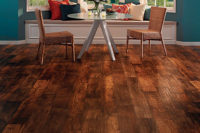Retail Technology Continues to Evolve at Rapid Pace

Dancik’s Order Manager, displaying an order on an iPad.
From smartphones to tablets, technology has begun to permeate every aspect of our business lives. Technology is available to help flooring retailers run a better business, both in the showroom and the back office. Software providers say the key to getting retailers to use industry-specific software is to make it as simple to operate as possible.
“Over the last 10 years, there has been a shift in people really starting to accept technology,” said Chad Ogden, QFloors president/ceo. “At the same time, a large percentage of retailers are still using things like QuickBooks and Excel. The problem is these programs are meant to be used by one or two people, not everyone in the company.”

A user works with QFloors retail flooring software.
Ogden noted what matters most is that the retailer can run a business smoothly and efficiently. “If we can just get people to do monthly financial statements, that’s how we know we’ve won,” he said.
According to Mitch Dancik, Dancik International’s president, another challenge for many retailers is having the infrastructure required to run a computer network. He predicts (in the not-too-distant future) many retailers will be running software off their mobile devices.

RFMS’s Sales Pro Mobile app.
Dancik noted that this shift could also change the way retailers and suppliers interact. “Many retailers don’t have the time to key in price lists; they don’t even have time to download them. They just want to wake up and, without pressing a button, the list is there. Suppliers may need to work with their retail customers to provide free apps and pieces of software that will have the price lists ready each day. That’s an infrastructure that doesn’t exist today.”
Dancik added his company is looking into offering “complete mobile entry order capability and mobile access to everything we supply here at Dancik.” He said software providers need to be prepared for online applications that could change the face of their business, such as someone creating a free estimating app. “That could happen so quickly. We all need to be that much more on the ball.”

This in-store kiosk concept from roomsalive includes the optional Surya area rugs program.
He noted that the old way, of jotting down notes on a notepad and bringing it over to the order desk, is on the way out. “On the retail side, capturing information is really important; capturing it digitally is critical. Retailers need to be able to input the information quickly and easily so they can focus on romancing the customer.”
Wheat said that people are becoming more receptive to technology, and retailers who use it in their business have a distinct advantage over those who do not. “Your customers have been researching all of the products they want on the Internet and probably know them better than your sales staff. It’s up to you to capture their attention immediately.”
Room visualization software that allows consumers to mix and match flooring and other products in virtual rooms is another important selling tool. The 3-D Home Design Planner, a visualization tool from roomsalive, is one feature of the company’s new in-store kiosk program.
“We feature professionally designed rooms from celebrity designer Marc Thee and his team,” said Hue Lien Duxbury, roomsalive’s vp B2B marketing. “You can mix and match many different elements, including flooring, paint, cabinetry, countertops, furniture and lighting.”
The touch-screen, modular kiosk system includes design videos, a real-time product library with search functions, an “inspiration gallery” of room scenes, and printable concept drawings. The retailer can also include a Surya area rug program as part of the kiosk.. A paint collection will also be available early next year.
“Everyone has seen the dip in business; retailers that are strong are looking at innovations that can help them market to consumers. Those that are already looking for new tools are the ones that are doing well,” Duxbury noted.
New Business Processes Coming from fcB2B Group
The Floor Covering Business to Business Association (fcB2B) has been hard at work on several projects, including a standard for electronically sending and receiving product catalogs, and a way to offer real-time inventory control.
According to fcB2B executive director Pamela Bowe, product catalogs are extremely complex to send and receive electronically, but the organization is close to figuring out a way to do it. “When you look at a catalog, there are all sorts of different measurements, product types and different attributes of the different products. The catalog needs to be able to account for all of those,” she said.
She noted that the upcoming fcB2B September meeting should iron out the final implementation guidelines for such a system. Additionally, the group hopes to have a method in place to offer real-time stock checking before the end of the year.
Bowe said the group is looking into web services, and “different ways to share, store and retrieve information” in order to create such a tool. “The way most people use the Internet now is similar to how web services are used. It’s a way to index stuff and immediately have it tell you what’s available, where it is, and the options available, similar to a search page on Amazon.”
The development phase will include an education period, service validation period and interoperability test period. Members can participate in all of these phases. For more information, visit www.fcb2b.org.
Looking for a reprint of this article?
From high-res PDFs to custom plaques, order your copy today!








